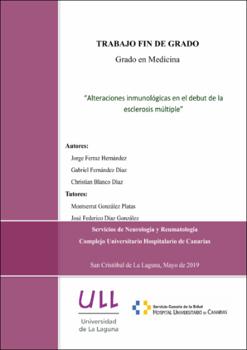Alteraciones inmunológicas en el debut de la esclerosis múltiple
Fecha
2020Resumen
Diseño
Estudio descriptivo, observacional, transversal y retrospectivo en el que revisamos las
historias clínicas de los pacientes que acuden al módulo de enfermedades
desmielinizantes del Servicio de NRL desde 17/7/79 hasta 5/3/19.
Objetivos
Describir la prevalencia de otras alteraciones autoinmunes en el momento del
diagnóstico de la esclerosis múltiple.
Métodos
Revisamos historias clínicas con sistema SAP, se analizaron datos de pacientes
diagnosticados de esclerosis múltiple desde 17/7/79 hasta 5/3/19 (577 historias).
Seleccionamos, aquellas que dispusieran del estudio analítico inmunológico en el
momento de diagnóstico (371 historias).
Se rellenó una base de datos anonimizada con datos biográficos, referentes a la
esclerosis múltiple, datos de RM, confirmación diagnóstica de EM, punción lumbar,
analitica con marcadores inmunológicos (TSH, T4
libre, ANA, ANCA, Autoanticuerpo
(Ac.) AntiTG, Ac. AntiTPO, Ac. Anti-ds DNA, Ac. Anti-Cardiolipina IgG, Ac.
Anti-Cardiolipina IgM, Ac. Anti- β2 Glicoproteína I IgG, Ac. Anti- β2 Glicoproteína I
IgM, Ac. Anti- Péptido de Gliadina IgA, Ac. Anti- Péptido de Gliadina IgG, Ac.
Anti-Transglutaminasa tisular IgA, Ac. Anti-Transglutaminasa tisular IgG, Ac.
Anti-Endomisio, Ac. Anti-MPO y Ac. Anti-PR3.
Los datos extraídos fueron analizados empleando el IBM SPSS® Statistics realizando
los cálculos pertinentes. Utilizamos descriptivos como media y desviaciones estándar y
se agruparon variables con resultados expresados en porcentajes.
Resultados
Se aprecia un mayor número de mujeres en la muestra del estudio, representando una
mayor afectación frente al sexo masculino. En cuanto a la clínica la mayoría de los
pacientes se encontraban asintomáticos (50,18%). Respecto a la TSH y T4 libre la
mayoría presentaron valores normales (83,77% y 94.63% respectivamente). Un
pequeño porcentaje de pacientes presentó alteraciones autoinmunes en el momento del
diagnóstico, ANA (15,18%) y ANCA (15,1%).
El resto de los valores sólo fueron positivos en 39 pacientes (10,51%).
Conclusiones
Debido al bajo número de pacientes con resultado positivo de marcadores autoinmunes
o demás valores analíticos elevados se puede afirmar que en la población analizada se
objetiva una baja prevalencia de asociación autoinmune. Design
Descriptive, observational, cross-sectional and retrospective study in the clinical records
of the patients who attended the module of demyelinating diseases of the NRL Service
from 7/17/79 to 5/3/19.
Goals
Describe the prevalence of the coexistence of multiple sclerosis and another
autoimmune alteration at the time of diagnosis of multiple sclerosis.
Methods We reviewed clinical histories with SAP system, we analyzed data of patients diagnosed
with multiple sclerosis from 17/7/79 to 5/3/19 (577 stories). We selected those who had
the immunological analytical study at the time of diagnosis (371 stories).
An anonymized database was filled in with biographical data, referring to multiple
sclerosis, MRI data, diagnostic confirmation of MS, lumbar puncture, analytical with
immunological markers (TSH, free T4, ANA, ANCA, Autoantibody (Ac.) AntiTG, Ac.
AntiTPO, Ac. Anti-ds DNA, Ac. Anti-Cardiolipin IgG, Ac. Anti-Cardiolipin IgM, Ac.
Anti-β2 Glycoprotein I IgG, Ac. Anti-β2 Glycoprotein I IgM, Ac. Anti-Gliadin Peptide
IgA, Ac. Anti-Gliadin Peptide IgG, Ac. Anti-tissue Transglutaminase IgA, Ac.
Anti-tissue Transglutaminase IgG, Ac. Anti-Endomysium, Ac. Anti-MPO and Ac.
Anti-PR3.)
The extracted data were analyzed using IBM SPSS® Statistics, performing the pertinent
calculations. We used descriptive as a mean and standard deviations and grouped
variables with results expressed in percentages.
Results
There is a greater number of women in the study sample, representing a greater
affectation compared to the male sex. Regarding the clinic, most of the patients were
asymptomatic (50.18%). Regarding TSH and free T4, the majority presented normal
values (83.77% and 94.63% respectively). A small percentage of patients presented
autoimmune alterations at the time of diagnosis, ANA (15.18%) and ANCA (15.1%).
The rest of the values were positive only in 39 patients 10,51%).
Conclusions
Due to the low number of patients with positive results of autoimmune markers or other
high analytical values, it can be affirmed that a low prevalence of autoimmune
association is observed in the analyzed population





